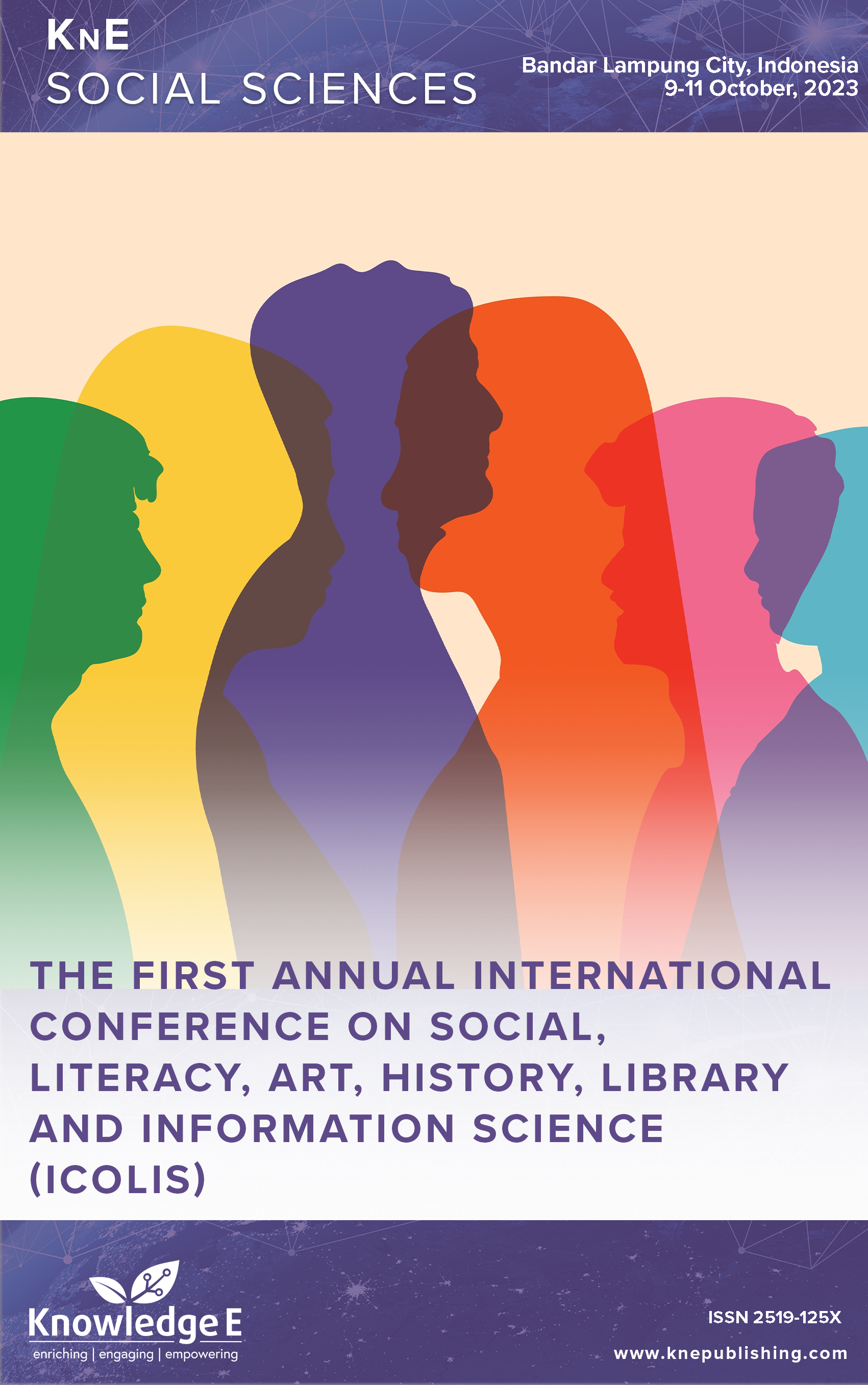Handwriting Habituation in Gen-Z Literacy Improvement with Brainwriting Method
DOI:
https://doi.org/10.18502/kss.v9i12.15846Abstract
Generation Z is coming of age in the digital era where computer technology and mobile devices have become very common. They are accustomed to computer keyboards and touchscreens rather than pens and paper. The ability to write on digital devices such as smartphones, tablets, or laptops has replaced much of the need for writing by hand. However, handwriting is a fundamental skill in literacy upgrades. This descriptive qualitative research explores how efforts to handwriting habituate Gen Z in enhancing literacy using the brainwriting method. The retrieval data methods used are observation, interviews, and literature analysis involving student samples with specific criteria. The study’s results indicate several factors of the respondents who infrequently write by hand, the exploration of the use of the brainwriting method, and its impact on the success of literacy among them. The outputs such as enhanced critical thinking, creativity, and communication that is not unilaterally dominated.
Keywords: Gen Z, handwriting, brainwriting, literacy
References
A., S., Sinha, P., & Ugwulebo, J. E. E. (2022). Digital literacy skills among African library and information science professionals – an exploratory study. Global Knowledge, Memory and Communication,ahead-of-print(ahead-ofprint) https://doi.org/10.1108/GKMC-06-2022-0138 DOI: https://doi.org/10.1108/GKMC-06-2022-0138
Azizah, A. (2015). Pembelajaran Menulis Puisi dengan Memanfaatkan Teknik Brainwriting pada Peserta Didik SD/MI Kelas V. Jurnal Ilmiah Pendidikan Dasar Vol. II No.2 Juli 2015, 137. DOI: https://doi.org/10.30659/pendas.2.2.136-140
Dangmei, J., Singh, A., & Professor, A. (2016). Understanding The Generation Z: The Future Workforce. In South-Asian Journal of Multidisciplinary Studies (SAJMS) (Vol. 3). https://www.researchgate.net/publication/305280948
Digital 2022: Indonesia. Data Reportal. https://datareportal.com/reports/digital-2022- indonesia
Dolot, A. (2018). The characteristics of Generation Z. E-Mentor, 74, 44–50. https://doi.org/10.15219/em74.1351 DOI: https://doi.org/10.15219/em74.1351
Ebi CH, S. (2017). Golden Age Parenting: Memaksimalkan Potensi Anak di Usia Emas (Erlinadani, Ed.). Psikologi Corner.
Haryadi. (2019). Pengaruh Model Pembelajaran Brain Writing terhadap Kemampuan Mahasiswa Menulis Artikel di Media Massa. http://jurnal.umpalembang. ac.id/index.php/bisastra/index
Herawati, I., Rizal, I., Amita, N., & Psikologi, F. (2022). The Impact of Social Media On Fear of Missing Out among Z Generation: A Systematic Literature Review. In Journal of Islamic and Contemporary Psychology (Vol. 2, Issue 2). DOI: https://doi.org/10.25299/jicop.v2i2.11179
Jin, K.-Y., Reichert, F., Cagasan, L. P., de la Torre, J., & Law, N. (2020). Measuring digital literacy across three age cohorts: Exploring test dimensionality and performance differences. Computers & Education, 157, 103968. https://doi.org/10.1016/j.compedu.2020.103968 DOI: https://doi.org/10.1016/j.compedu.2020.103968
Linnes, C., & Metcalf, B. 2017. iGeneration and Their Acceptance of Technology. International Journal of Management & Information System. Vol. 21. No. 2, pp. 11-26 DOI: https://doi.org/10.19030/ijmis.v21i2.10073
Marwiyati, S. (2020). Penanaman Pendidikan Karakter melalui Pembiasaan. DOI: https://doi.org/10.21043/thufula.v8i2.7190
Michalko, M. (2004). Permainan Berpikir = (Thinkertoys) . Kaifa.
Moleong, L. J. (2018). Metodologi Penelitian Kualitatif. PT Remaja Rosdakarya.
Irianto, P. O., & Febrianti, L. Y. (2017). Pentingnya Penguasaan Literasi bagi Generasi Muda dalam Menghadapi MEA.
Irene B. Levitt, Erlia Simamora (translator). (2005). Brain Writing. Bhuana Ilmu Populer.
Ray, K., Dally, K., Rowlandson, L., Tam, K. long, & Lane, A. E. (2022). The Relationship of Handwriting Ability and Literacy in Kindergarten: A Systematic Review. Read Writ, 35, 1119–1155. DOI: https://doi.org/10.1007/s11145-021-10224-8
Shaturaev, J. (2019). The Importance of Handwriting in Education. International Journal of Advanced Research, 7(12), 947–954. https://doi.org/10.21474/IJAR01/10237 DOI: https://doi.org/10.21474/IJAR01/10237
Sumartini, & Hernawan. (2019). Model Brain Writing dalam Meningkatkan Kemampuan Menulis Wawangsalan. Lokabasa, 10(2), 214–225. https://doi.org/10.17509/jlb.v10i2 DOI: https://doi.org/10.17509/jlb.v10i2.21364
Sugiyono. (2016). Metode Penelitian Kuantitatif, Kualitatif, R&D. PT. Remaja Rosdakarya.
Thompson, R. A., & Nelson, C. A. (2001). Developmental Science and the Media: Early Brain Development. American Psychologist, 56, 5–15. DOI: https://doi.org/10.1037//0003-066X.56.1.5
Mustofa, M. B., & Wuryan, S. Urgensi Komunikasi Interpersonal Dalam Al- Qur’an Sebagai Pustakawan. Al-Hikmah Media Dakwah, Komunikasi, Sosial dan Kebudayaan, 2020; 11(2): 85-94. https://doi.org/10.32505/hikmah.v11i2.2544 DOI: https://doi.org/10.32505/hikmah.v11i2.2544
Mustofa, M. B., Febrian, M. K., & Wuryan, S. Strengthen Interpersonal Communication in Improving Library Services for People with Disabilities. Wasilatuna: Jurnal Komunikasi dan Penyiaran Islam, 2023; 6(02): 64-75. https://doi.org/10.38073/wasilatuna.v6i02.1029 DOI: https://doi.org/10.38073/wasilatuna.v6i02.1029
Wuryan, S., Mustofa, M. B., Saputra, R., & Cahyani, M. P. Pengaruh Gaya Komunikasi Kepemimpinan dalam Pengelolaan Organisasi: Tinjauan Analisis. KOMUNIKASIA: Journal of Islamic Communication and Broadcasting, 2023; 3(1): 1-23. https://doi.org/10.32923/kpi.v3i1.3349 DOI: https://doi.org/10.32923/kpi.v3i1.3349
Mustofa, M. B., Sugara, G. T., & Wuryan, S. Komunikasi Interpersonal Sebagai Strategi Untuk Meningkatkan Kepuasan Pengunjung: Sebuah Tinjauan Literatur di Perpustakaan. Al-Idza’ah: Jurnal Dakwah dan Komunikasi, 2023; 5(1): 30-46. https://doi.org/10.24127/al-idzaah.v5i1.3571 DOI: https://doi.org/10.24127/al-idzaah.v5i1.3571
Amaliah, E., Mustofa, M. B., Kesuma, M. E. K., Wuryan, S., Ramadaniah, D., & Tamara, S. D. Peranan Teknologi Informasi Komunikasi Sebagai Media Pelayanan di Perpustakaan INSTIDLA. Tik Ilmeu: Jurnal Ilmu Perpustakaan dan Informasi, 2022; 6(2): 279-294. http://dx.doi.org/10.29240/tik.v6i2.5075 DOI: https://doi.org/10.29240/tik.v6i2.5075
Mustofa, M. B., Iqbal, R., Budianto, A., & Hidayat, N. Integrasi Tradisi Literasi Keagamaan (Yasinan) Dalam Terciptanya Budaya Kerukunan Masyarakat. Nusantara Journal of Information and Library Studies (N-JILS), 2022; 5(1): 51-59. https://doi.org/10.30999/n-jils.v5i1.2002
Mustofa, M. B., Kesuma, M. E. K., Yunita, I., Amaliah, E., & Rahmawati, D. I. Pemanfaatan Media Pustaka Digital Dalam Membangun Perpustakaan Desa Berbasis Inklusi Sosial Di Masa Pandemi. Jurnal Informasi, Perpustakaan, dan Kearsipan ( JIPKA), 2021; 1(1): 1-13. http://dx.doi.org/10.26418/jipka.v1i1.51150
Mustafa, M. B., Wuryan, S., & Meilani, F. Komunikasi Verbal dan Nonverbal Pustakawan Dan Pemustaka Dalam Perspektif Komunikasi Islam. At- Tanzir: Jurnal Ilmiah Prodi Komunikasi Penyiaran Islam, 2021; 12(1): 22-36. https://doi.org/10.47498/tanzir.v12i1.510 DOI: https://doi.org/10.47498/tanzir.v12i1.510
Mustofa, M. B., Wuryan, S., & Husnita, T. J. Komunikasi Vertikal Dan Horizontal Antara Pustakawan Dan Pemustaka Dalam Layanan Perpustakaan Persfektif Islam. Al-Idza’ah: Jurnal Dakwah dan Komunikasi, 2021; 3(01): 1-9. https://doi.org/10.24127/alidzaah. v3i01.1517 DOI: https://doi.org/10.24127/al-idzaah.v3i01.1517
Mustofa, M. B., Putri, M. C., Wuryan, S., & Rahmawati, D. I. Aktivitas Komunikasi Interpersonal Pustakawan Dalam Meningkatkan Etos Kerja. Nusantara Journal of Information and Library Studies (N-JILS), 2021; 4(1): 89-102. https://doi.org/10.30999/njils. v4i1.1293
Mustofa, M. B., Wuryan, S., Sholiha, N. A., Arif, M. M., & Musa, M. Kontribusi Komunikasi Interpersonal dalam Perspektif Islam di Lingkungan Organisasi UIN Raden Intan Lampung. KOMUNIKASIA: Journal of Islamic Communication and Broadcasting, 2021; 1(1): 56-68. https://doi.org/10.30999/n-jils.v4i1.1293 DOI: https://doi.org/10.32923/kpi.v1i1.1839
Mustofa, M. B., Silvia, I., & Basyori, A. Proses Komunikasi Interpersonal Dalam Lingkup Perpustakaan Melalui Model Konseling Layanan Pemustaka. Jurnal El-Pustaka, 2021; 2(1). http://dx.doi.org/10.24042/el-pustaka.v2i1.8769

